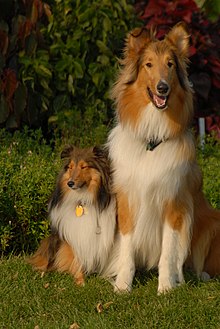Shetland Sheepdog
| Shetland Sheepdog | ||
|---|---|---|
|
|
||
| FCI Standard No. 88 | ||
|
||
| Origin : | ||
| Alternative names: |
Sheltie |
|
| Withers height: |
ideal: male 37 cm |
|
| List of domestic dogs | ||

The Shetland Sheepdog or Sheltie is a British breed of dog recognized by the FCI ( FCI Group 1, Section 1, Standard No. 88 ).
Origin and history
The Sheltie comes from the Shetland Islands in north-east Scotland and is a cross between border collies and Greenland dogs brought by whalers , which was later refined by collies . According to an old story, the race to King Charles Spaniel on breeding operation be involved.
The Sheltie was introduced in Great Britain at the end of the 19th century. In 1909 breeders founded the Shetland Collie Club in Lerwick , whose members wanted to breed the Collie in miniature . This met with the strong resistance of the collie breeders, especially since the Sheltie was by no means a uniform type at the time. It so happened that it was not officially recognized by the Kennel Club until 1914. Even today, his breeding base, although he is a popular house dog, is significantly less than that of the Collie.
description
According to the standard , males should be 37 cm tall and bitches 35.5 cm tall, with deviations of 2.5 cm up and down being tolerated. In terms of size, Shelties are very variable, so that there are also dogs that are significantly larger or smaller. The Shetland Sheepdog is a long-haired dog without any clumsiness or coarseness and is well proportioned. Lush coat, mane and ruff in the colors sable-white / sable (formerly yellow-white), dark sable-white (mahogany) / darksable or shaded sable , tricolor (three colors : black, white, brown), black-white / bi -black , blue merle (silvery gray with black spots or black marbled markings , white, tan ) and blue merle without tan / bi-blue , formerly black and tan (black-brown without white markings - now extinct). In terms of appearance, it is the small version of the Collie.
Thanks to the thin and straight hair that does not become matted and hardly absorbs dirt, the Sheltie does not require particularly high maintenance.
Essence
The FCI breed standard describes the nature of the Shetland Sheepdog as follows: “Alert, gentle, intelligent, strong and lively. Loving and understanding towards his master, reserved towards strangers, never nervous. "
use
The Sheltie is a herding dog and companion dog . It can be found in dog sports ( agility , obedience , dog dancing , flyball , discdogging, rarely protective dog sports ) and as a rescue dog or therapy dog .
Breed specific diseases
Shetland sheepdogs show an increased incidence of dermatomyositis , a genetic skin and muscle disease in young dogs, which is usually milder than in collies.
As with Collies, the Shetland Sheepdog has the MDR1 defect , which causes hypersensitivity to several drugs . Another hereditary disease is the Collie Eye Anomaly . When mating merle-colored dogs with each other, malformations of the eyes can occur.
Web links
- Breed standard No. 88 of the FCI: Shetland Sheepdog (PDF)
- Sheltie page of the German Club for British Sheepdogs
Individual evidence
- ↑ Hans Räber: Encyclopedia of dog breeds . 1st edition. tape 1 . Kosmos, Stuttgart 2001, ISBN 3-440-06555-3 , pp. 319 ff .
- ↑ a b SHETLAND SHEEPDOG FCI No. 88. FCI, 23 August 2013, accessed on 4 March 2016 .
